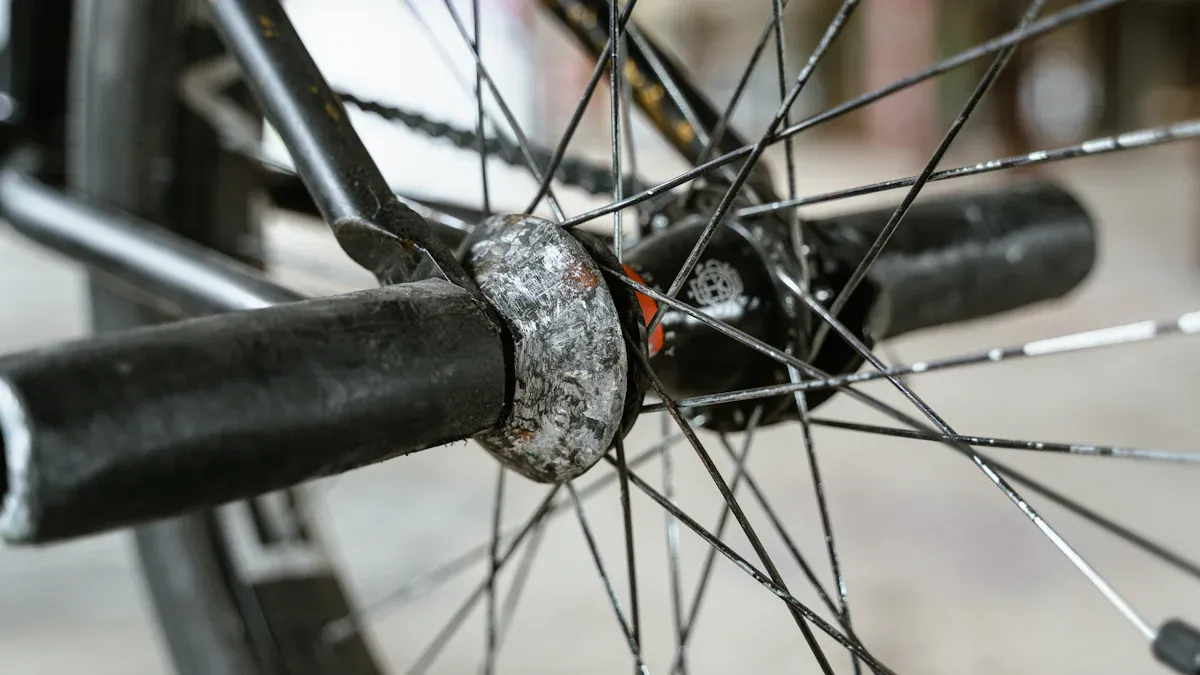
You can expect your alloy bike frame to last 5 to 10 years if you take care of it. Your riding style, weight, and how often you ride are important. Knowing these things helps you care for your bike frame better. This can help it last longer. Regular maintenance and checking for damage can really help your bike last.
Key Takeaways
Alloy bike frames usually last between 5 and 10 years. This depends on how you ride and take care of them.
Your riding style, weight, and how often you ride affect how long your bike frame lasts.
Cleaning it often, checking for damage, and getting professional help can make your frame last longer.
Look for cracks, dents, strange noises, and paint damage. These are signs your frame needs help.
You should replace your frame if the damage is bad or if repairs cost more than a new frame.
Lifespan of Alloy Frames

Average Lifespan
An alloy bike frame usually lasts about 5 to 10 years. This depends a lot on how you use and care for your bike. If you ride casually and do regular maintenance, your frame can last longer. But if you push your bike hard, it may not last as long.
For example, casual riders who go about 2,000 miles each year can have a long life from their aluminum bike frames. On the other hand, cyclists who ride over 6,000 miles a year should expect a shorter lifespan. Aggressive riding, like racing, puts more stress on the frame. This can make it wear out quickly, sometimes in just one season.
Factors Affecting Durability
Many things affect how long your alloy bike frame lasts:
Rider Weight: Heavier riders put more pressure on the frame. This can cause faster wear. If you weigh more, pick a frame made for extra strength.
Riding Style: How you ride matters a lot. Aggressive riders who jump or race will put more strain on their frames. This can cause fatigue and cracks over time.
Frequency of Use: The more you ride, the more stress your frame gets. Aluminum bike frames have a limit to how much they can take. They will eventually fail from repeated stress. Regular checks are important. Cracks in the paint can be an early sign of wear.
Environmental Factors: Things like salt and pollution can hurt your bike frame’s life. For example, magnesium alloy frames rust faster in salty areas. They can lose weight 47% faster than aluminum in salt tests. Protective coatings can help reduce these problems.
By knowing these factors, you can take steps to make your alloy bike frame last longer. Regular maintenance and careful riding will help your bike serve you well for many years.
Maintenance to Extend the Life
Regular Care Practices
To keep your alloy bike frame in great shape, you should follow some regular care steps. These steps help your bike frame last longer and avoid expensive repairs. Here are some important maintenance tips:
Clean Your Bike Regularly: Try to clean your bike every two weeks. Even if it seems dry or dusty, dirt can harm it over time. Use soap and degreasers made for bikes for the best results.
Inspect for Damage: Check your frame often for cracks or dents. If you see any damage, fix it quickly to prevent more problems.
Lubricate Moving Parts: Keep the pivot points, especially on suspension parts, well-lubricated. This helps everything work smoothly and reduces wear.
Professional Servicing: Get a professional service at least once a year. This keeps your frame and suspension in good condition.
Proper Washing Techniques: When washing, put degreaser on the chain and let it sit. Wash the frame from top to bottom with a sponge, paying attention to hard-to-reach spots. Rinse gently and dry well to stop moisture buildup.
Avoid Moisture Accumulation: After cleaning, make sure your bike is completely dry. Moisture can cause rust, which shortens the life of your bike frame.
Tip: Pair your maintenance with good riding habits. Smooth pedaling and avoiding rough impacts lower stress on the frame.
Seasonal Tips
Seasonal changes can change how you care for your bike. Here are some tips to keep your alloy bike frame in great shape all year:
Winter Care: Keep your bike indoors during winter. This protects it from moisture and elements that cause rust.
Monthly Protection: In wet or humid areas, spray your frame with silicon once a month. This helps resist rust and protects the paint.
Post-Ride Cleaning: After rides in mud or rain, clean your bike frame with warm soapy water and a soft cloth. This stops dirt and moisture from building up.
Use a Cleaning Kit: Think about using an all-in-one bike cleaning kit. It’s handy for travel and helps you maintain your bike in different conditions.
Protect Internal Parts: Watch out for moisture inside the frame. Use sprays with linseed oil to protect internal steel parts, especially in tubes and brackets.
By following these maintenance steps and seasonal tips, you can greatly extend the life of your alloy bike frame. Regular care and attention will keep your bike working well for many years.
Signs of Damage on Your Bike Frame

Visual Indicators
You should check your alloy bike frame often for signs of damage. Here are some common things to look for:
Cracks: Wash the frame and look closely for cracks. Tell the difference between paint cracks and real frame cracks.
Surface Irregularities: Run your fingers over the frame. Feel for bumps or bends, which show fatigue.
Weld Quality: Look at the welds carefully. Smooth welds are good. Rough or uneven welds might hide cracks.
Component Inspection: Check parts like the stem and handlebars for cracks or extra flexibility. These can be early signs of fatigue.
Corrosion: Look for rust, especially near the bottom bracket. This often shows up near cracks or where paint is gone.
Pay attention to these signs. Aluminum fatigue can cause sudden breakage when signs appear.
Performance Issues
You might notice problems that show damage to your bike frame. Here are some common issues to watch for:
Unusual Noises: Listen for creaking or groaning sounds while riding. These noises often come before visible frame damage.
Flexing: Notice if the frame bends a lot during rides. This can mean weakening at joints or brazing.
Changes in Geometry: Be aware of any changes in frame shape, like wheels moving closer together. This can be an early sign of damage.
Flaked Paint: Look for flaked paint or a feeling that the bike does not feel right while riding. These can show underlying issues.
Stress Points: Common stress points include the bottom bracket and mounting eyelets. Repeated bending can make the frame brittle.
Ignoring these signs can lead to serious failure. Early detection through checking for noises and flex can help prevent accidents.
When to Replace Your Alloy Frame
Assessing Damage
If you see damage on your alloy bike frame, check how bad it is. Start by looking at what kind of damage it is. Here are some common situations:
Scrapes on thick, low-end alloy: You can carefully file or sand the scrape until it is even with the frame. This works well for small damage and helps you watch for cracks.
Dents or gouges on thin-walled high-end frames: In this case, it’s best to replace the frame. Thin tubes might be weak, so repairs may not work well.
Badly gouged areas: You could think about covering these spots with sheet metal and epoxy. But this might only be a temporary fix.
Damaged aluminum wrapped with carbon fiber: While this method works in other fields, it is not proven for bike frames.
Wrapping with steel on aluminum: Don’t choose this option because it can cause galvanic corrosion, which speeds up damage.
By knowing these types of damage, you can make better choices about fixing or replacing your frame.
Cost vs. Replacement
When deciding to repair or replace your bike frame, think about the costs. Here are some important points to keep in mind:
Aluminum bike frames usually cost between $200 and $500.
Maintenance for these frames is low. You mainly need to clean them and fix any scratches.
Yearly maintenance costs are about $50 to $100, which is not much.
Aluminum frames do not rust, so you don’t have to maintain them as often compared to other materials.
Over time, the total maintenance costs stay low and are much less than buying a new alloy bike frame.
Many cyclists decide to replace their frames instead of fixing them for a few reasons. For example, cracks often happen in high-stress spots, leading to frame replacement. If repairs cost more than the bike’s worth, getting a new frame is smarter. Personal experiences show that fixing steel frames is usually easier than fixing alloy frames.
In conclusion, your alloy bike frame can last 5 to 10 years if you take care of it. Regular maintenance is very important for making your bike last longer. You should clean your bike often, check for damage, and fix any problems quickly. Knowing the signs of wear can help you find issues early. By doing these things, you make sure your bike stays dependable and fun for many rides ahead.
FAQ
How can I tell if my bike frame is damaged?
Check your bike frame often for cracks, dents, or strange noises. Look closely at welds and stress points. If you see any problems, think about getting a professional check.
What maintenance should I perform on my bike frame?
You should clean your bike frame often, oil moving parts, and look for damage. Getting a professional service once a year also helps keep it in good shape.
Can I repair a damaged alloy bike frame?
You can fix small scrapes or dents on thicker alloy frames. But big damage usually needs a replacement, especially for thin, high-end frames.
How does riding style affect my bike frame’s lifespan?
Riding hard, like racing or jumping, puts more stress on your bike frame. This can cause faster wear and possible damage compared to easy riding.
What environmental factors can harm my bike frame?
Salt, pollution, and moisture can hurt your bike frame’s life. Cleaning it regularly and using protective coatings can help reduce these problems.
See Also
Advantages And Disadvantages Of Aluminum Bike Frame Strength
Comparing Enduro Frame Materials For Durability And Strength
Essential Tips For Caring And Maintaining Steel Bike Frames
